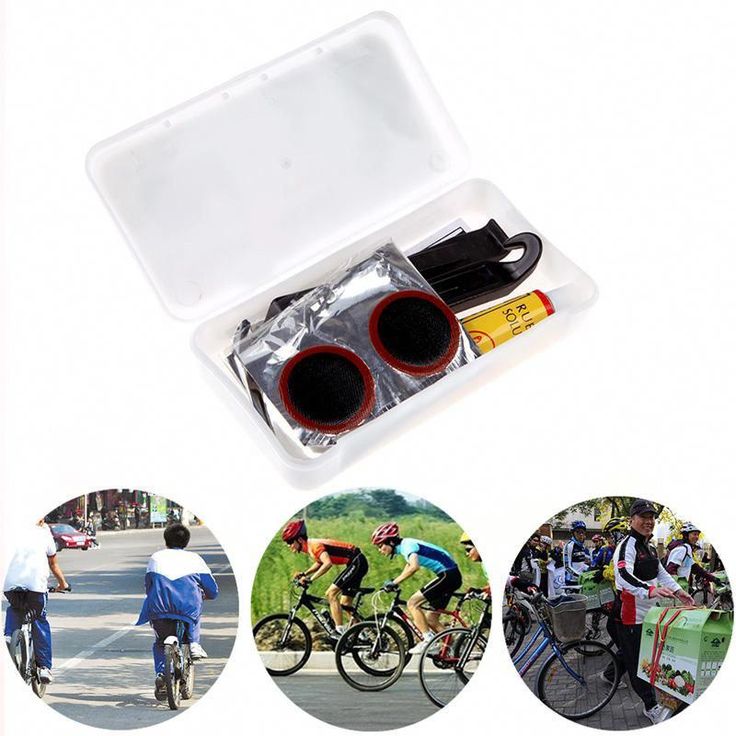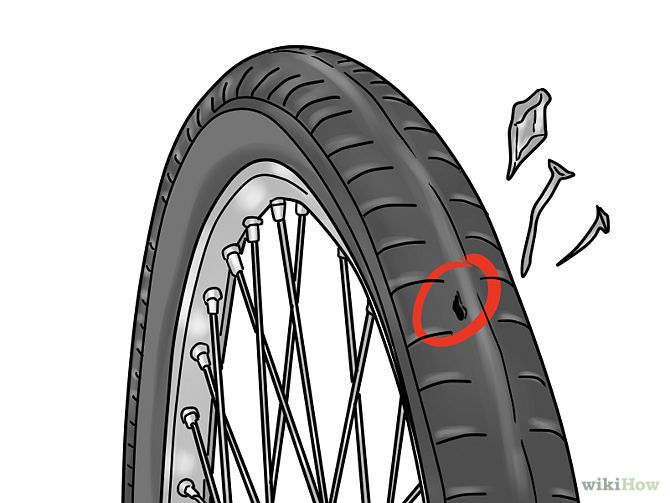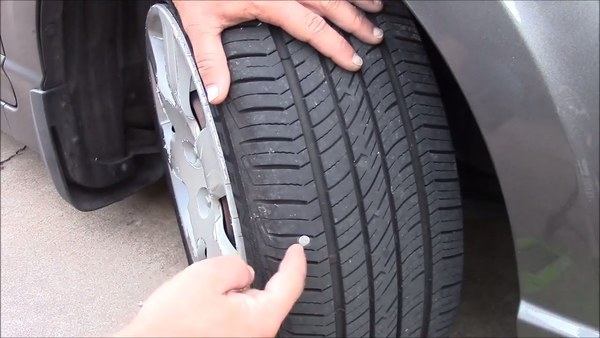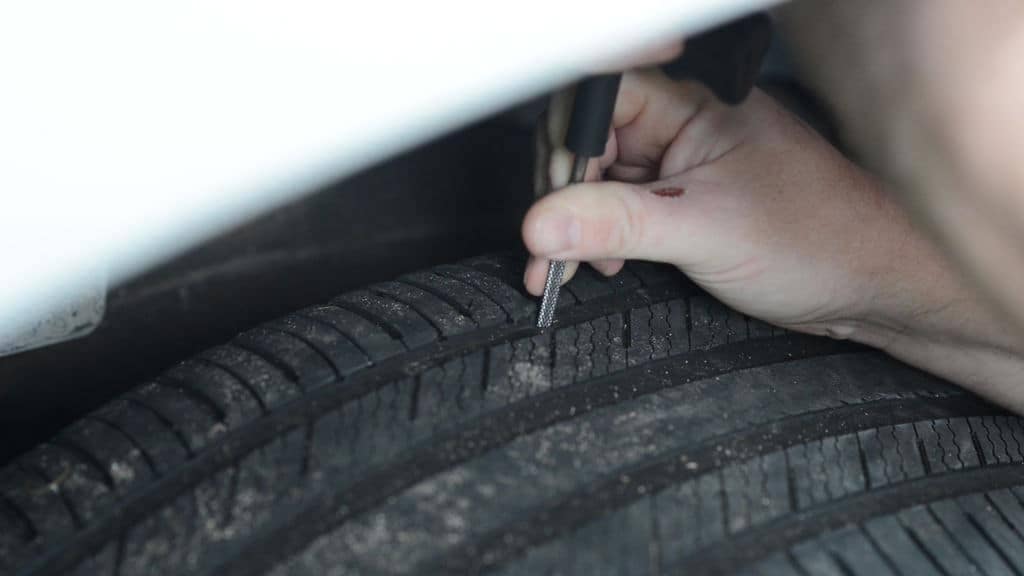By Admin
Posted in Uncategorized
Flat tires can happen at any time and can make you feel helpless. But if you are armed with some information and quick fixes, you should be back on the road quickly.
If you notice that your tire is flat but still has some air in it, you might be able to fix it with a tire patch as long as the hole is not in the sidewall. You should never drive on a tire that is more than ten pounds low on air. If the leak allows the rest of the air out, you could end up driving on the rim, which will cause damage. So what should you do when it seems like your tire is low?
Jack the vehicle up using the jack points closest to the tire. Slowly rotate the tire to find the problem. If you don’t see an object sticking out of the tire or a hole, there’s a trick to discovering the leak. Make a mixture of liquid soap and water.
As you brush the water on the tire, the mixture will create bubbles where the hole is located. If you mark the hole with chalk or white shoe polish you can easily find it again.
If the hole was caused by a nail or screw and is small, you can plug the tire, but larger holes will need to be patched. A tire plug kit contains two T handles: One has a point and a rough shaft and the other has an “eye” at the end of it.
Air the tire up to about five pounds over the recommended pressure. Next, thread a plug through the eye on the smooth-shafted T handle. Insert the T handle without the eye into the hole in the tire. Push it in and pull it out three or four times. Remove the T handle and then push the plug-loaded T handle into the hole in the tire so that the plug is all the way inside the tire. Pull the T handle out. The plug will stay in the tire and will be visible.
While you can patch a tire yourself, it may be better to bring your car to a tire shop. You must first remove the tire to install the tire patch and then remove the tire from the rim. While it’s possible to do this yourself, it can get pretty complicated.
You must first remove the tire to install the tire patch and then remove the tire from the rim. While it’s possible to do this yourself, it can get pretty complicated.
If the hole is too big to plug, you shouldn’t try to drive. A hole that’s big enough for a patch will leak quickly. The easiest and best thing to do to avoid damaging your rim is bring the tire to a tire repair center.
If you must drive the vehicle, remove the damaged tire and wheel, and install the spare. If you have another mode of transportation, remove the tire and wheel, and bring it to a tire repair center so it can be repaired safely.
You can drive for many miles on a plug or patch, however, if you notice another leak it may be time to head to a service center. If you need a second tire patch, the tire is ready to be replaced.
Safety is always the number one priority. A tire patch can help with a small leak, but if more than one is needed, it’s time for a replacement.
Every editorial product is independently selected, though we may be compensated or receive an affiliate commission if you buy something through our links. Ratings and prices are accurate and items are in stock as of time of publication.
Modern vehicle tires are tough, standing up well to rough terrain and thousands of miles of driving. Trouble is, tires are not invincible. Every so often car tires spring leaks. Air can start leaking from anywhere on a tire, and the location of the leak determines whether or not you can fix it yourself. And if you can't fix it yourself, the location of the leak will also tell you if you need a professional repair or a new tire.
Whether or not your tire is tubed or tubeless affects things, too, because only tubeless tires can be repaired using the technique of plugging that we'll show you here. The good news is that modern vehicles always have tubeless tires, and this means that repairing with a rubber plug is often an option.
The good news is that modern vehicles always have tubeless tires, and this means that repairing with a rubber plug is often an option.
Plugging a tubeless tire is only a possibility when your puncture is in the tread area. If the air leak is where the sidewall of the tire meets the rim — this is called a "bead leak" — you'll need to visit a mechanic with a tire machine to dismount the tire from the rim and remount it with sealing liquid applied to the bead. If your sidewall has been punctured, you need a new tire, because damage there can lead to a blowout at highway speeds, even after repair.
Learn exactly how to plug a tire so next time you spring a leak between your treads, you'll be able to get up and running again in record time.
Total time completing the repair is about 15 minutes. Doing the work yourself will save you about $20 and the time spent driving to the garage and waiting.

Steve Maxwell for Family Handyman
Complete DIY projects like a pro! Sign up for our newsletter!
Do It Right, Do It Yourself!
Originally Published: August 27, 2020
esportby.com
An easy way to quickly restore tire tightness and continue your journey. True, for this you need to have the right wheel repair kit with you.
True, for this you need to have the right wheel repair kit with you.
Maxim Stroker
“Catching” a nail, screw or piece of wire in a wheel on the track is a trifling matter and somewhere even everyday. However, it turns into a serious "trouble" if this happens, for example, at night or a couple of tens of kilometers from the nearest tire fitting point. In theory, in this case, you need to put a spare wheel and go further. Although, in the case of a family trip on vacation, the process of digging it out from under a pile of junk in the trunk can turn into an adventure that deserves a separate story. Be that as it may, often the trouble does not come alone and the spare tire can be broken literally on the next kilometer. After all, where one carnation fell on the road, there may well be another one, and another, and another ...
With a couple of crippled wheels, you'll either have to wait an unknown amount of time for a tow truck to be sent in, or fix it yourself. Therefore, in a not particularly urbanized area, it makes sense to carry a repair kit with you to eliminate punctures in tubeless wheels. In principle, it can be of any manufacturer. The main thing when choosing it in the store is to make sure that the “drill” included in the repair kit is not very toothy and sharp. After all, his task is simply to clear a puncture hole in the tire, and not to break its metal cord. The second recommendation: the flagella, which are supposed to close the puncture hole, should be plump and reinforced with thin wire or plastic threads.
In principle, it can be of any manufacturer. The main thing when choosing it in the store is to make sure that the “drill” included in the repair kit is not very toothy and sharp. After all, his task is simply to clear a puncture hole in the tire, and not to break its metal cord. The second recommendation: the flagella, which are supposed to close the puncture hole, should be plump and reinforced with thin wire or plastic threads.
n-i.kiev.ua
And the third criterion for choosing a wheel repair kit is the obligatory presence of a tube of glue in it. Yes, yes: there are also “glueless” sets on sale, which are essentially useless.
So, we notice that the wheel is flat (or has already been blown off) and proceed to eliminate the problem. Most often, the hole in the rubber is not visible. Therefore, to begin with, we hang out the damaged wheel by raising the car on a jack, and inflate it with a pump or compressor to 3-4 atmospheres. If even after that it is not possible to detect damage by the whistle of escaping air, we methodically and consistently wet the entire surface of the wheel and look for bubbles at the puncture site.
Having found a puncture, we take the “drill” from the set and pierce the damaged area with it several times. So we clean the surface of the hole before gluing. Next, we smear the “drill” with glue from the set and again immerse it in the hole. We repeat this operation and, leaving the “drill” sticking out in the hole smeared with glue, we take out the flagellum and insert it halfway into the eye of another tool - the “overgrown needle” (sometimes called the “awl”), also available in the repair kit. We coat the flagellum with glue and, quickly pulling the “drill” out of the hole, insert our “needle” there so that the ends of the flagellum remain above the surface of the wheel tread. Next, we pull out the “needle-awl” and wait a few minutes until the glue grabs. After that, we pump up the wheel and carefully cut off the protruding tails of the flagellum with a knife. Everyone, you can move on.
Test drive of one of the best family minibuses
19842
 Zen
Zen wheels, summer tires, cheap cars, repairs, tires, winter tires, track
Unit / system: Wheels
Fault: How to fix a puncture in the road
Never drive on a flat tire!
Possible consequences of failure to eliminate
Driving on a flat tire or with low pressure can lead to complete tire wear, deformation of the rim, as well as to an emergency!
First of all, you need to try to pump up the wheel and get to the tire shop. In case the wheel deflates very quickly, it is necessary to apply a special Liqui Moly sealant spray.
The use of the Reifen-Reparatur-Spray Tire Repair Spray allows you to quickly and independently repair and inflate tubeless tire punctures when operating the car in places remote from the service. Allows you to get to the tire shop without changing the wheel. The contents of the cylinder are sufficient for pumping into a tire up to size 215.
Code: 3343
Volume: 0.5 l
Do not use if the tire is torn or comes off the rim. It is not recommended for use in the presence of a centralized tire pressure monitoring system.